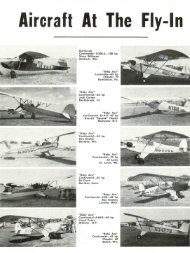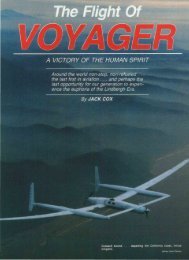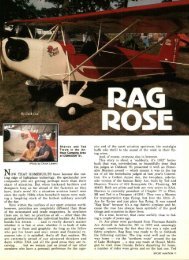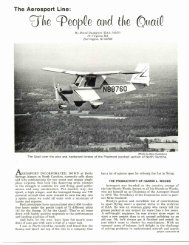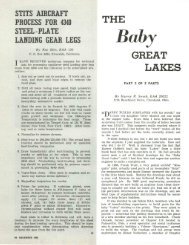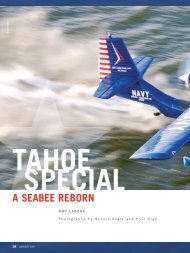You also want an ePaper? Increase the reach of your titles
YUMPU automatically turns print PDFs into web optimized ePapers that Google loves.
off the airways, and the corner of a triangular test area<br />
that I had asked for and gotten. Ted Smith of FAA<br />
showed up on schedule, made his inspection, and finished<br />
filling out the paperwork. I put 5 gals, of gas in the<br />
tank, since I wanted the ship to be light for the first<br />
flight and to reduce the fire hazard — just in case. This<br />
proved to be a mistake, but only one of several to be<br />
made that day.<br />
Since the freshly-overhauled engine had only three<br />
hours of block time and an hour of running in the ship,<br />
we decided to run it in for another hour while taxi-testing<br />
the ship and trying out the brakes and steering.<br />
<strong>The</strong>re was nothing wrong with this — the later troubles<br />
came from over-anxiety to get into the air and the Go-<br />
Go-Go atmosphere generated by the now sizeable crowd<br />
made up of all the local aero-nuts who could get away<br />
from their jobs. I put on a parachute and taxied out to<br />
the end of the runway. <strong>The</strong> first two hops were to be<br />
low drags down the runway with the wheels just off<br />
the ground to test trim and controllability at low power,<br />
and all went well. On the full-throttle run, "<strong>Fly</strong> <strong>Baby</strong>"<br />
jumped into the air and then the engine sputtered. I<br />
(Photo by Bowers)<br />
Ribs are band sawed from Vs in. plywood, then fitted<br />
with '/» in. by Vt in. slotted cap strips. All were built by<br />
one person in a single Saturday. Wing tip bows are laminated<br />
from !/e in. J Sfl$p$, and ailerons are carried on Cspar<br />
behind rear wing 'spar. Compression ribs are steel<br />
tubing, one of few tyelded assemblies in the ship, and<br />
drag wires are Va in. 1x19 stranded wire.<br />
set down right away and taxied back past the crowd to<br />
try again. Again it happened, so I cut out further attempts.<br />
Since the ship had been given a fuel flow test before<br />
coming to the field and the engine had worked fine on<br />
the full-throttle demonstration for FAA, we were stumped.<br />
We thought that maybe the fuel line had a restriction<br />
or was a bit too small, so put on another and went out<br />
to try again later in the day. This time the throttle was<br />
advanced more slowly to cut down on acceleration and<br />
backward fuel surge, and things seemed to be going OK<br />
until at 20 ft. altitude at low speed with the nose up, the<br />
engine quit cold. With no power and no speed, there was<br />
nothing to do but hold on tight. <strong>The</strong> impact bent the<br />
axles and the steel axle support plates gouged into the<br />
sides of the wooden landing gear struts. Fortunately, the<br />
prop didn't hit the ground so this was the only damage.<br />
<strong>The</strong> ship was able to taxi back to the line under its own<br />
power.<br />
It was several months, long after I had put in a<br />
shorter and still-larger fuel line, that I found out what<br />
had happened. In looking at a photo taken just before<br />
the first take-off, I noticed that the wire fuel level indicator<br />
that sticks out of the cap of the Piper J-3 fuel<br />
tank was all the way down.<br />
<strong>The</strong> hour of engine running had used up most of the<br />
5 gals, that had been put in and no one, neither myself<br />
(Photo by Bowers)<br />
Joe Roskie puts the final bits of hardware store aluminum<br />
flashing to the leading edge of the right wing before covering<br />
with Dacron from Sears.<br />
« ».<br />
nor a single one of the spectators, pilots all, had noticed<br />
the warning that was there for everyone to see! <strong>The</strong> "preflight"<br />
inspection had been made BEFORE the engine<br />
run, and was not repeated before the flight. <strong>The</strong> lesson<br />
learned, fortunately at relatively low cost, was a double<br />
one — first, don't get in a hurry concerning test<br />
flights, and second, forget the weight handicap and fill<br />
the tank for the first flight. While the tank-to-carburetor<br />
relationship was exactly the same in "<strong>Fly</strong> <strong>Baby</strong>" as it was<br />
in the J-3 "Cub", the lighter homebuilt had considerably<br />
more acceleration with the same power and the small<br />
amount of fuel aboard surged to the back of the tank,<br />
behind the outlet, so the engine was running only on<br />
what was in the sediment bowl. With higher fuel levels,<br />
there was no further problem, but I did make a rule of<br />
"No take-off below % full" as used on Cessna 140s, etc.<br />
Well, it took a day to straighten out the metal<br />
landing gear parts, add a stiffening fairing to the<br />
straight-across tube axle, make two new wooden V-strut<br />
assemblies, and get it all back on the ship. With a full<br />
tank, the first real flight was highly successful, and "<strong>Fly</strong><br />
<strong>Baby</strong>" was at last ready for Rockford, but with only<br />
an hour and four minutes on it. FAA wouldn't let it go<br />
cross-country with only this, so it got loaded back on<br />
the glider trailer and three of us, Jack, Tony, and myself,<br />
left Seattle on Saturday afternoon. Two days and<br />
(Continued on next page)<br />
(Photo by Victor D. Seely)<br />
Those '/s in. plywood ribs are HUSKY. Note that Pete is<br />
standing on the RIBS, not on the spars! Don't try this<br />
stunt until you get the stabilizing tapes in, or the ribs<br />
will bow sideways and break.<br />
SPORT AVIATION 7



